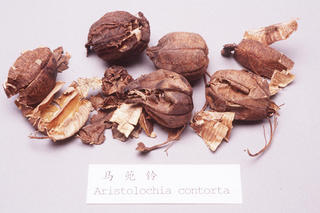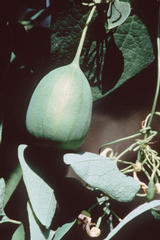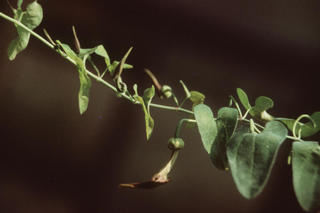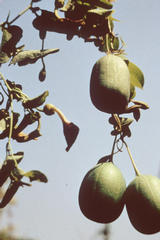Aristolochia debilis
Contents
- 1 Nomenclature
- 2 Historical Use of Aristolochia debilis
- 3 Background
- 4 Nomenclature
- 5 Historical Use of Aristolochia debilis
- 6 Background
- 7 Nomenclature
- 8 Historical Use of Aristolochia debilis
- 9 Background
- 10 Pharmaceutical Information
- 11 Evidence or the Use of Aristolochia debilis in the Treatment of Epilepesy
- 12 Safety
Nomenclature
Other Names:
Historical Use of Aristolochia debilis
Aristolochia debilis in Traditional Chinese Medicine
Background
Zhidouling Ö˶µÁå
Chinese Name (pinyin): Madouling
Chinese Name :
Common Name :Aristolochia Fruit
Specific Name : Fructus aristolochiae
Scientific Name:
Collection : The drug is collected in autumn when the fruit turns from green to yellow and dried.
Description : Ovoid, 3 - 7cm long, 2 - 4cm in diameter. Outer surface yellowish green, greyish green or brown with 12 longitudinal ribs from the extending numerous horizontal parallel veinlets. Apex flattened and obtuse, base with slender fruit stalk. Pericarp light and fragile, easily divided into 6 splitlings. Inner surface of pericarp smooth and lustrous with dense transverse veins. Fruit 6 locular, containing many seeds in each locule, ovelapped and arranged regularly. Seeds flattened and thin, obtuse triangular or fan shaped, 6 - 10mm long, 8 - 12mm wide, winged all around, pale brown, odour charactestic, taste slightly bitter.
Identification : to 3g of the powder add 50ml of ethanol, heat under reflux on a water bath for 1 hour, filter. Evaporate the filtrate to dryness, dissolve the residue in 5ml of ethanol as the test solution. Extract the reference drug of Fructus Aristolochiae in the same manner, use the extract as the reference solution (1), use 0.5mg per ml solution of aristolochic acid CRS in ethanol as the reference solution (2). Carry out the method for thin chromatography (Appendix Vl B) using silica gel G as the coating substance and the upper layer of toluene-ethyl acetate water-formic acid (20:10:1:1) as the mobile phase. Apply in strip separately to the plate 5µl of each of the three solutions. After developing and removal of the plate, dry it in the air and examine under ultra violet light (365nm). The fluorescent strips in the chromatogram obtained with the test solution correspond in position and color to the strips in the chromatogram obtained with the reference solutions.
Processing : Eliminate foreign matter, sift and rub the fruit to pieces.Processed with honey: Stri fry as describe under the method of stir frying with honey (Appendix ll D) until not sticky to fingers.
Action : To remove heat from the lung and relieve cough and asthma, and to remove heat from the large intestine (rectum) for the treatment of hemorrhoid.
Indication : asthma, cough, bloddy sputum due to heat in the lung; bleeding, swollen and painful hemorrhoids due to heat in the large intestine
Precautions :
Dosage : 3 to 9 g.
Storage : Preserve in a dry place.
Nomenclature
Other Names:
Historical Use of Aristolochia debilis
Aristolochia debilis in Traditional Chinese Medicine
Background
Chinese Name (pinyin): Tianxianteng
Chinese Name :
Common Name :Dutchmanspipe Vine
Specific Name : Herba aristolochiae
Scientific Name:
Collection : The drug is collected in autumn, remove from foreign matter and dried in the sun
Description : Stem slenderly cylindrical, slightly twisted, 1 - 3mm in diameter, externally yellowish green or pale yellowsih brown with longitudinal ridges and nodes, internodes varying in length, texture fragile, easily broken. Fracture exhibiting several vascular bundles of variable size. Leaves alternate, mostly crumpled, broken when whole, deltoid-narrow-ovate and cordate at the base. Dark green or pale yellowish brown, basal ones obviously veined, slenderly petioled, odor delicately aromatic and taste weak.
Identification : Stem slenderly cylindrical, slightly twisted, 1 - 3mm in diameter, externally yellowish green or pale yellowsih brown with longitudinal ridges and nodes, internodes varying in length, texture fragile, easily broken. Fracture exhibiting several vascular bundles of variable size. Leaves alternate, mostly crumpled, broken when whole, deltoid-narrow-ovate and cordate at the base. Dark green or pale yellowish brown, basal ones obviously veined, slenderly petioled, odor delicately aromatic and taste weak.
Processing : Elminate foreign matter and cut into sections.
Action : To promote the flow of qi and blood, and to induce diuresis.
Indication :
Precautions :
Dosage : 4.5 to 9 g.
Storage : Preserve in a dry place, protected from mould.
Nomenclature
Other Names:
Historical Use of Aristolochia debilis
Aristolochia debilis in Traditional Chinese Medicine
Background
Chinese Name (pinyin): Qingmuxiang
Chinese Name :
Common Name :Slender Dutchmanspipe Root
Specific Name : Radix aristolochiae
Scientific Name:
Collection : The drug is collected in spring and autumn, removed from rootlets and soil and dried in the sun.
Description : Cylindrical or compressed cylindrical, slightly tortuous, 3 - 15 cm long, 0.5 - 1.5 cm in diameter. Externally yellowish brown or greyish brown, rough and uneven, exhibiting longitudinal wrinkles and rootlet scars. Texture fragile, easily broken, fracture uneven, bark pale yellow, wood broad, rays whitish arranged radially, cambium ring distinct, yellowish brown. Odour aromatic and characteristic, taste bitter.
Identification : 1.Transverse section: Cork of several rows of brown cells. Cortex scattered with oil cells containing yellowish brown oil droplets. Phloem relatively broad also scattered with oil cells. Cambium in a ring. Xylem rays broad, parenchyma well developed, xylem usually exhibiting several longer and larger xylem bundles arranged radially outward from the center and other smaller consisting of vessels, tracheids and wood fibers. Vessels up to 120 µm in diameter. Parenchymatous cells containing starch granules, simple granules rounded or elliptical up to 117 µm in diameter. Compound granules of 2 - 21 components.2.To about 3g of the powder add 50 ml of ethanol, heat under reflux for 1 hour, filter, evaporate the filtrate to dryness. Dissolve the residue in 5 ml of ethanol and use it as the test solution. Prepare a reference drug solution of Radix Aristolochiae in the same way as that described for the test solution. Dissolve Aristolochic with CRS in ethanol to produce a solution containing 0.5 mg per ml use as the reference solution. Carry out the method for thin layer chromatography (Appendix Vl B) using silica gel H containing sodium carboxymethyl cellulose as the coating substance and a mixture of benzene-methanol-glacial acetic acid (5:0.8:0.1) as the mobile phase. Apply separately 5 µl of each of the above three solutions to the plate. After developing and removal of the plate, dry it in the air. Examine under the sun light annd ultra violet light (365 nm). A spot in the chromatogram obtained from the test solution correspond in colour and position to the spot in the chromatogram obtained from the solution of reference drug.
Processing : Eliminate foreign matter, wash clean, soften thoroughly, cut into thick slices and dry.
Action : To relieve pain by sbduing hyperactivity of the liver, and to counteract toxicity and cause subsidence of swelling.
Indication : dizziness, headache and distending pain in the chest and abdomen; carbuncles, boils, snake bite and insect bite
Precautions :
Dosage : 3 to 9 g; for external use, appropriate quantity to be ground into powder for topical application.
Storage : Preserve in a cool and dry place.
Synonymns for Aristolochia debilis
Patent Medicines and Medicines with Multiple Ingredients that include Aristolochia debilis
Pharmaceutical Information
Chemical Constituents
Evidence or the Use of Aristolochia debilis in the Treatment of Epilepesy
Basic Science
Animal Studies
Cohort, Case-Control and Non-Randomized Trials
Randomized Controlled Trials
Meta-Analysis
1st Five Results: pubmed search
Meilin Chen, Chongjun Zhao, Zhiqi Li, Qiqi Fan, Shan Lu, Xiaoyu Tao, Yifan Lin, Ruichao Lin, Jiarui Wu
Investigation of the applicability of the zebrafish model for the evaluation of aristolochic acid-related nephrotoxicity.
Phytomedicine: 2023, 121;155092
[PubMed:37804820]
[WorldCat.org]
[DOI]
(I p)
Koya Hashimoto, Takayuki Ohgushi
Asymmetric interactions between two butterfly species mediated by food demand.
Ecol Evol: 2023, 13(6);e10164
[PubMed:37304371]
[WorldCat.org]
[DOI]
(P e)
Xiaotao Tuo, Zhiyin Yu, Junheng Li, Yuxin Qi, Guoqing Peng, Sheng-Xiong Huang, Xueshuang Huang, Jian-Ping Huang
Characterization of two putative norlaudanosoline methyltransferases from Aristolochia debilis.
J Plant Physiol: 2023, 285;153983
[PubMed:37116390]
[WorldCat.org]
[DOI]
(I p)
Li Liu, Lin-Chong Hui, Shou-Rong Yu, Yu Li, Shu-Yan Liu
##Title##
Mycoscience: 2022, 63(4);169-175
[PubMed:37090474]
[WorldCat.org]
[DOI]
(P e)
Shu-Han Zhang, Yun Wang, Jing Yang, Dan-Dan Zhang, Yan-Lei Wang, Shu-Hui Li, Ying-Ni Pan, Hua-Min Zhang, Yi Sun
##Title##
Toxins (Basel): 2022, 14(12);
[PubMed:36548776]
[WorldCat.org]
[DOI]
(I e)



